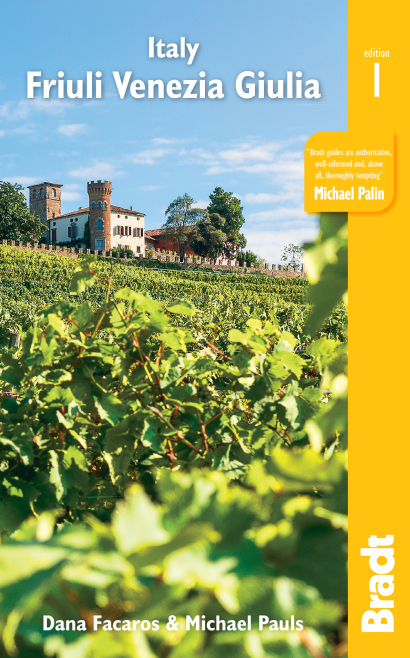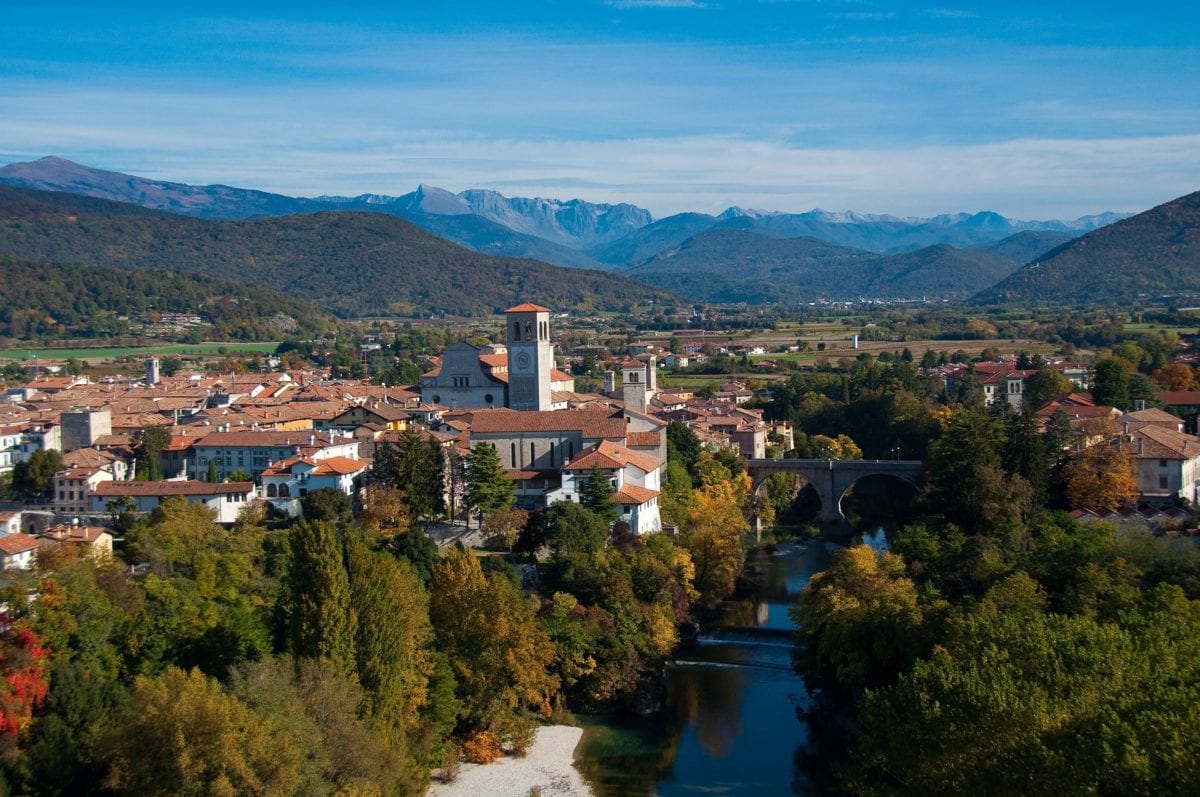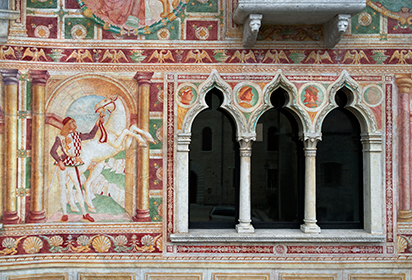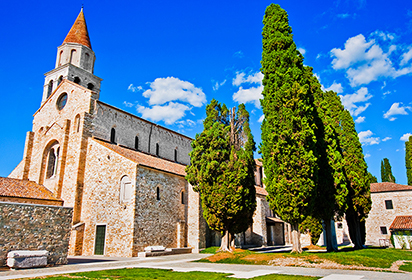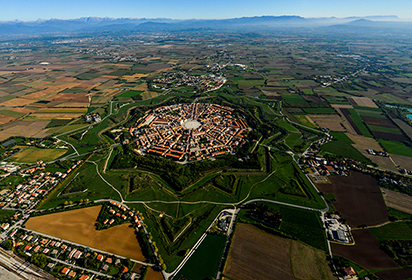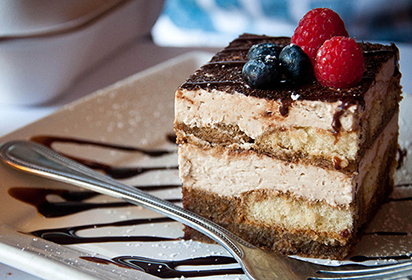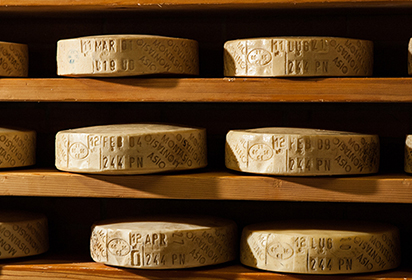In the furthest corner of northeast Italy lies one of the country’s best-kept secrets – Friuli Venezia Giulia, a travel destination where you can enjoy some of the best Italy has to offer without the crowds and the hassles.
Dana Facaros and Michael Pauls, authors of Italy: Friuli Venezia Giulia: the Bradt Guide
There’s a little bit of everything here, in a small, cosy space. On top are the mountains: folkloric Carnia, the delicate and lovely pinnacles of the Friulian Dolomites, and the sunny Julian Alps, full of opportunities for skiing and every winter sport, amid hidden Alpine villages where time stopped long ago. In the middle are plains, punctuated by the lofty bell towers of village churches, a Friuli tradition.
The famous vines of the Collio grow here, in landscapes that create an elegant backdrop for the region’s towns of art and culture: Udine, Cividale del Friuli, Gemona, Spilimbergo and Gorizia. Below, Friuli’s coast is a stretch of peaceful lagoons, full of wildlife and colour, between two urbane and delightful beach resorts – Grado and Lignano Sabbiadoro.
The lost Roman metropolis of Aquileia is here too, and the strange geometric Renaissance fortress city of Palmanova. Then there’s Trieste, the cosmopolitan, fun-loving, mellow old capital – a great city-break destination. Trieste’s dramatic coast features the imperial Castello di Miramare, while right above the city is the peculiar Carso, land of Slovenes, sinkholes and underground rivers.
Friuli Venezia Giulia has everything in place, starting with a warm welcome, a remarkable regional cuisine, great wines, hiking and biking trails for enjoying the outdoors, plus excellent museums and monuments. This is a region waiting to be discovered.
Food and drink in Friuli Venezia Giulia
One of the delights of visiting any region in Italy is discovering new dishes, and FVG, with its smorgasbord of culture, combined with its mountains, fertile plains, orchards (notably cherry) and coast delivers the goods in spades. Polenta and dumplings are more important than pasta; cheese and butter have major roles and there’s a marked preference for combining sweet and savoury tastes inherited from Mitteleuropa.
Many dishes may already be familiar to fans of American Italian-Croatian celebrity chef Lidia Bastianich: she and her son Joe own a vineyard near Cividale del Friuli. Some recipes go back to the ancient Romans, such as brovada (turnips pickled in marc as an accompaniment to meats), while others use ingredients seldom seen elsewhere such as radic di mont (wild alpine chicory shoots, preserved in oil), sclopit (bladder campion leaves) and urticions or cima di luppolo (hops shoots) both used in a frittata or risotto. Then there’s rosa di Gorizia, a beautiful red rose-like radicchio used in salads, and sea buckthorn berries used for scirop di pomulis di gleria, drunk as cordial.
A good reference site for information, food itineraries, and wine and food producers open to visits is www.tastefvg.it.
Health and safety in Friuli Venezia Giulia
Health
In most cases, EU citizens with an EHIC (European Health Insurance Card) are entitled to free care in Italy from the national health system, the SSN (Servizio Sanitario Nazionale). Non-EU citizens should take out travel insurance. There will be a hospital, clinic or health unit (Azienda Sanitaria) with a Pronto Soccorso (casualty/first-aid department) in every town of any size. Pharmacy staff are trained to assist with minor problems. If a pharmacy is closed when you need it, look for the card in the window with the schedule of the farmacia di turno (the closest one open) or call 1100 for the details of the three nearest pharmacies. Most doctors and pharmacists speak rudimentary English.
Safety
Friuli Venezia Giulia has a very low crime rate, but it’s always best to take the same precautions you take elsewhere, and not leave temptations visible in the car. Scooter-borne purse-snatchers can be foiled if you stay on the inside of the pavement and keep a firm hold on your property (sling your bag-strap across your body, not dangling from one shoulder).
Women travelling alone should not encounter any particular problems. If possible, try to avoid arriving or leaving big city stations late at night. There have been complaints of harassment, though no more or less than in any other European city.
For LGBTQ+ travellers, a certain amount of discretion may be called for in country towns as you may encounter confusion and animosity, especially among teenagers and the elderly. Arcigay Trieste Gorizia and Arcigay Friuli are local branches of a national organisation for the LGBTQ+ community, with local news and events. Also see www.guidagay.it for gay-friendly hotels in Italy.
Friuli Venezia Giulia is working on making the region one of the most accessible for all, although wheelchair users may well have difficulties in steep Alpine villages. Most hotels have at least one room designed for wheelchair travellers; public toilets and most restaurant toilets are accessible. Trenitalia provides free assistance to wheelchair users with 24 hours’ notice. Big city stations (Trieste, Venice, Mestre) have a Sala Blu for travellers with disabilities where journeys can be arranged; assistance is also available at Cervignano-Aquileia-Grado, Gorizia, Latisana, Monfalcone, Pordenone, Sacile, Trieste Airport and Udine, all of which can booked 24 hours in advance.
Travel and visas in Friuli Venezia Giulia
Visas
Citizens of EU member states and holders of passports from some 50 nations do not need a visa for stays of 90 days or less. These include Australia, Canada, Hong Kong, Israel, Japan, Malaysia, Mexico, New Zealand, South Korea, Singapore, Switzerland and the USA.
Getting there and away
By air
The nearest airports are in Trieste, Venice and Treviso. While Venice gets considerably more traffic, especially in season, Trieste has good year-round links with European hubs.
By bus
Flixbus runs from Marseille to Trieste with stops in the major cities across southern France and northern Italy, and in the other direction to Fiume (Rijeka) in Croatia. Florentiabus runs twice daily from Florence, and to Sofia, Bulgaria, with connections for Ljubljana, Slovenia, and Zagreb, Croatia.
By sea
There are car ferries once a week, more often in summer, to Trieste from Durrës (Durazzo), Albania. In summer, frequent passenger-only hydrofoils connect Trieste to the Istrian ports of Piran (Slovenia) and Poreč, Rovinj and Pula (Croatia).
Getting around
Friuli Venezia Giulia has excellent public transport, as well as an exceptional network of cycling paths.
By train and bus
Trenitalia operates much of the country’s rail network. Tickets can be purchased up to three months in advance – your best chance to bag a discount. Economy fares and family fares are available if you purchase the ticket at least two days in advance. If you change your mind, you have up until 23.59 on the day before travel to change it one time only. Tickets must be validated (convalidato) in the green or yellow machines located in the ticket hall or on the platform before boarding.
Italian bus services are excellent: modern, clean, frequent, punctual and inexpensive, generally cheaper to travel on than trains and indispensable if you’re travelling without a car. They reach even the smaller villages (although often only once or twice a day on weekdays).
By car
Driving can be fun, fast and pricey on the autostrade (major thoroughfares are the A4 Venice–Trieste and the A23 Palmanova–Udine–Tarvisio) but slow and frustrating in cities, and white-knuckle scary on some of the smaller, narrow mountain roads (we’re looking at you, SR552, between Meduna and Ampezzo!). Although the signposting is decent, it’s very easy to get lost; if you hire a car, plump for GPS and you’ll avoid a lot of stress.
When to visit Friuli Venzia Giulia
Friuli Venezia Giulia offers something for every season: in winter snow and sports in the mountains (where Carnival in February is a very big deal), and a chance to visit art cities Trieste and Udine without the crowds. Spring temperatures are perfect for touring by car, by bike or on foot, and May and June bring flowery Alpine meadows. Summer is perfect for lolling on the beaches and for sports in the mountains, while autumn with its cooler temperatures brings on the colour in the mountains and in the Carso, fewer crowds, and mushrooms and game dishes in the restaurants.
Climate
Most of FVG enjoys a very agreeable climate. Average daily highs in the centre range from 8° to 8.5°C in December and January, to 28°C in July and August. Precipitation is spread throughout the seasons; it’s slightly rainier in the spring and in September and October. The variety of landscapes means a variety of climate too. Weather in Trieste is much the same as Udine for most of the year, but on average a couple of degrees colder in winter, with an occasional touch of snow. This comes courtesy of the Bora, the northeast wind that can come shooting down from the Carso at up to 150km/h.
Up in the mountains, of course, it’s a very different story. Much cooler temperatures year-round are the rule. If you’re here in winter (and most of autumn and spring), do as the locals do and check the meteo every morning before setting out.
What to see and do in Friuli Venezia Giulia
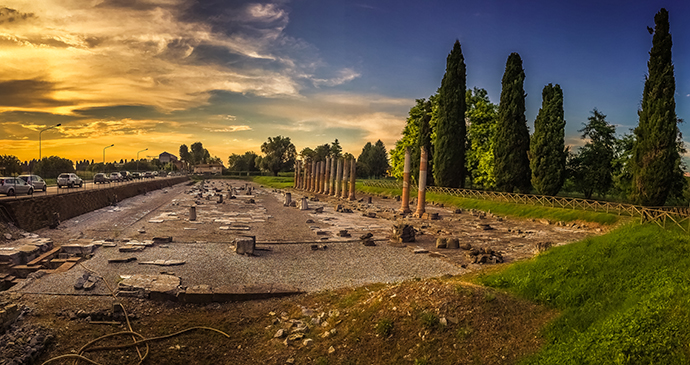 Aquileia is home to some of Italy’s most important Roman ruins © Lytd11, Shutterstock
Aquileia is home to some of Italy’s most important Roman ruins © Lytd11, Shutterstock
Aquileia
Amid the farms and gardens of this very green part of Friuli, you’ll come to a tiny town that was once the fourth largest city in Italy, with a population of 100,000. Aquileia is unique in that it was the only great Roman-era city in Italy to shrink into a village; all the others not buried in volcanic mud evolved into modern towns or cities. Though a tiny town, it is an exceedingly handsome one, with scores of stately cypresses, and bits of antique sculpture set into its walls. Today Aquileia’s 3,500 inhabitants no longer receive emperors, but build yachts (Solaris shipyards are here) and tend to their vineyards and the tourists who flock to see the most important Roman archaeological site in northeast Italy – a UNESCO World Heritage Site since 1998.
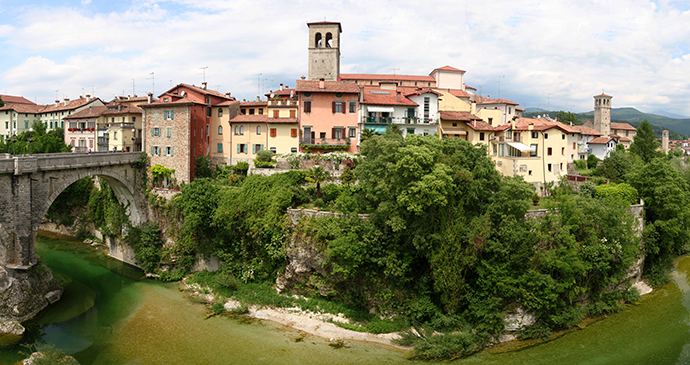 Cividale overlooks the Natisone river © JRP Studio, Shutterstock
Cividale overlooks the Natisone river © JRP Studio, Shutterstock
Cividale del Friuli
East of Udine, Cividale del Friuli is a jewel with an impressive pedigree. Julius Caesar founded it in 50BC and named it Forum Iulii after his family – a name that was condensed over the centuries into ‘Friuli’. But it was the Lombards who followed and left Cividale the remarkable relics given World Heritage status in 2011. It isn’t the best location. Cividale’s wealth of art and culture has been rocked by earthquakes many times, most recently in the great quake of 1976. Some of the damage from that one is still being repaired.
The centre of Cividale is a series of squares that mark the ancient forum. The most important, Piazza Duomo, is the site of the lively Saturday morning market, under the eyes of a bronze statue of founding father Julius Caesar (1935, a copy of a Roman marble). This stands in front of the picturesque Palazzo Comunale, built in the 13th century over the ruins of a Roman house (now in the courtyard). Its façade is emblazoned with a Lion of St Mark and bust of Domenico Mocenigo, the Venetian Provveditore remembered for his good work during the plague of 1682.
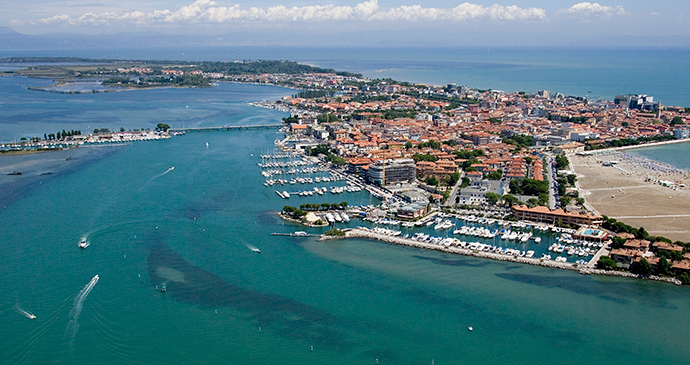 Grado is one of the Adriatic’s premier resorts © PTFVG
Grado is one of the Adriatic’s premier resorts © PTFVG
Grado
Grado is ‘Little Venice’, another safe lagoon city founded by Roman refugees in the dangerous Dark Ages. It never achieved the incredible destiny of the big Venice, but as a centre of ecclesiastical power at least it survived. Now, Grado’s destiny is to be one of the most attractive beach resorts on the Adriatic. Even in Italy, it isn’t as well known as it deserves to be. The ‘Golden Island’ reigns as the queen of its own lagoon, sprinkled with 30 islands large and small and 3km of golden sandy Blue Flag beaches. Best of all, it’s a real place, with a historic centre that goes back to Roman times, a couple of canals to remind us that the Venetians once ruled here, and some fascinating monuments from the earliest Middle Ages.
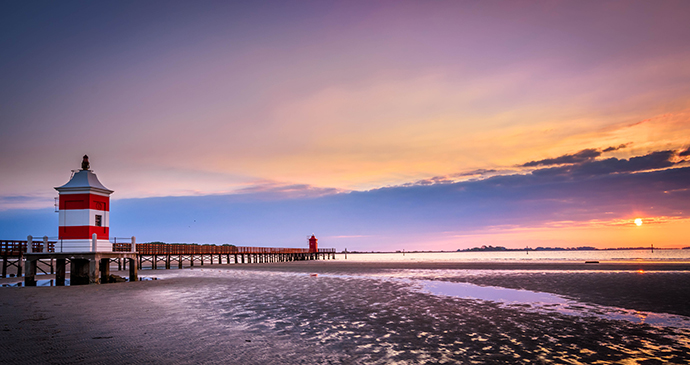 Sunrise at Punta Faro’s ‘red lighthouse’ on the shore of Lignano Sabbiadoro © sabrisy, Shutterstock
Sunrise at Punta Faro’s ‘red lighthouse’ on the shore of Lignano Sabbiadoro © sabrisy, Shutterstock
Lignano Sabbiadoro
In 1945 one of the last and oddest battles of the war was fought on the sandy, mostly empty peninsula of Lignano, between retreating Germans and New Zealanders. Not long after that, businessmen were already making plans for its perfect, unspoiled beaches. In 1954 Ernest Hemingway visited, just before the bulldozers arrived, and dubbed it ‘the Florida of Italy’. Papa nailed it: today Lignano ‘Sabbiadoro’ (golden sands) is the Palm Beach of Friuli, a fun-in-the-sun success story with a peak summer population of 300,000 (more than Trieste), 8km of massive, wide sandy Blue Flag beaches, more than 200 accommodation options, 3,600 other spots to bunk in from apartments to camp pitches, a spa, golf course, five amusement parks and one of the largest marinas in Italy, with more than 7,000 berths. To some readers, all that might sound dire. But in a way that maybe only Italians can pull off, Lignano manages to be a happy, urbane and unfailingly pleasant place. Bring the kids.
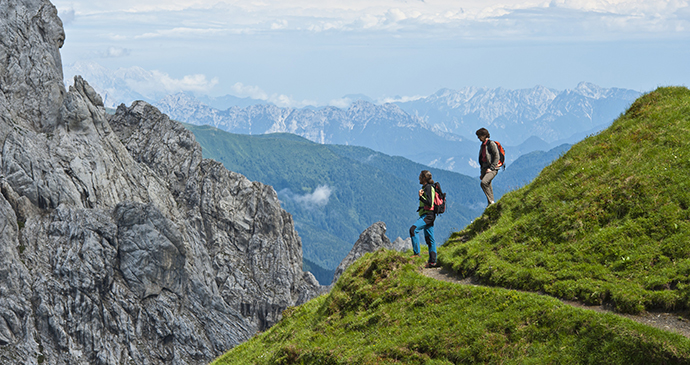 The Friulian Dolomites are an outdoor lover’s paradise © Mario Vechin, PTFVG
The Friulian Dolomites are an outdoor lover’s paradise © Mario Vechin, PTFVG
Parco Naturale Dolomiti Friulane
For many, this will be Friuli’s star attraction: one of the most scenic and pristine patches of northern Italy. The Friulian side of the Dolomites has never attracted the same attention as the side in the Veneto, but that has made it perfect for the sort of nature tourism that is increasingly popular. The Dolomiti are impressive enough from the valleys, on the roads that follow the Tagliamento or the Cellina, but it is only when you hike up into them that you can really appreciate their delicate peaks and spires – some of the most beautiful mountain landscapes in the world.
The Dolomiti Friulane are a relatively compact area between the Piave valley, the upper Tagliamento valley and the Val Tramontina. Much of it is encompassed in the Valcellina and Parco Naturale Dolomiti Friulane. Created in 1992, this is one of only four natural sites in Italy to make UNESCO’s World Heritage list, precisely because the core peaks – Cima dei Preti (2,706m), Duranno (2,652m), Cridola (2,581m), Cima Monfalconi (2,548m), Spalti di Toro (2,386m) and the sublime solitary Campanile di Val Montanaia (2,173m) – are still refreshingly untouched. There are no villages at all within the park borders – not even any roads.
The quiet, rugged villages around the periphery are an attraction in themselves; their friendly people help make them perfect bases for exploring the mountains. Barcis and its lovely green lake make an exceptionally relaxing setting. The western end of the Dolomites brings a surprise: the incredible Vajont Dam, and the memory of the terrible tragedy of 9 October 1963, the Vajont tsunami.
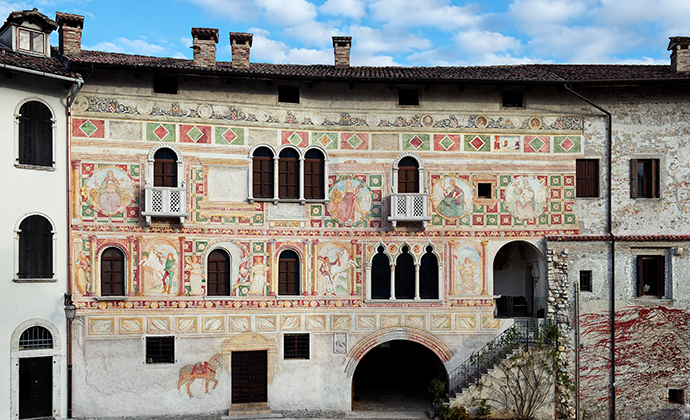 Full-blown Renaissance marvels are common in Spilimbergo © FotoCiel, PTFVG
Full-blown Renaissance marvels are common in Spilimbergo © FotoCiel, PTFVG
Spilimbergo
Pordenone and other towns have their bits of colourful outdoor fresco, but Spilimbergo is the real painted lady of Friuli. A score of Renaissance painted palazzi help make its city centre one of the most delightful in the region, with a surprise around every corner. Spilimbergo has several other feathers in its cap: handsome medieval architecture, excellent places to eat, a famous school of mosaics and a Saturday market that brings in everyone from around the surrounding countryside.
The town goes back to Roman times, but it takes its name from the Spengenbergs of Carinthia, the future Counts of Spilimbergo, who arrived in the 11th century and set up shop on an easy ford across the Tagliamento, where they could easily tax merchandise. They became ministriales (officials) of the Patriarch of Aquileia, but often rebelled against him, notably during the feudal conflict of 1350. A walled town, the Borgo Vecchio, grew up around the castle, then expanded over the centuries to include new borghi, including Valbruna, where workers lived in little lanes and inner courtyards.
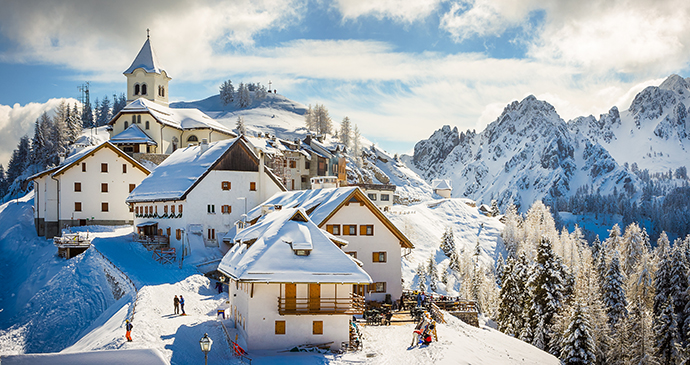 Tarvisio is FVG’s premier winter sports resort © Alfio Finocchiaro, Shutterstock
Tarvisio is FVG’s premier winter sports resort © Alfio Finocchiaro, Shutterstock
Tarvisio
Up in Italy’s northeast corner, Tarvisio in its narrow mountain bowl is the resort queen of the Valcanale – the only valley in Europe, they say, where four languages are spoken (Italian, Friulano, German and Slovenian). In 1007, Emperor Saint Henry II gave the town and the Valcanale – and its valuable mines and timber – to the Bishop of Bamberg. In 1758, he sold Tarvisio to the Empress Maria Theresa, and it remained part of Carinthia until it passed to Italy in 1918.
Tarvisio stands at the centre of the Foresta di Tarvisio, one of the largest forests in Italy. It’s beautiful country, perfect for every sort of mountain activity, and Tarvisio itself, in an open, sunny corner of the valley, makes a perfect base. In the centre you’ll see a bust of Cajetan Schnablegger, no less than the founder of tourism in these parts. Schnablegger was the heir to the zinc mines. In the 1880s he opened the first hotels and a spa here – and printed Friuli’s first tourist brochures.
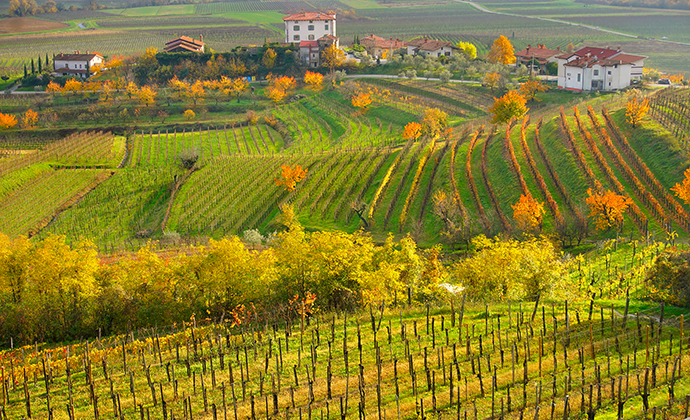 Vineyards of the Collio, home of Friuli’s acclaimed white wines © Luciano Mortula, LGM Shutterstock
Vineyards of the Collio, home of Friuli’s acclaimed white wines © Luciano Mortula, LGM Shutterstock
The Collio
The pretty hills north and west of Gorizia, the Collio (or Brda in Slovenian) resembles a patch of Tuscany that got away. Olive trees grow along the edges of the vines, cypresses and fruit trees, woods and little bodies of water that attract wildlife and maintain biodiversity. There isn’t much in the way of sights: just lovely landscapes for touring with lovely hotels and agriturismi, superb food and some of the finest white wines on planet Earth.
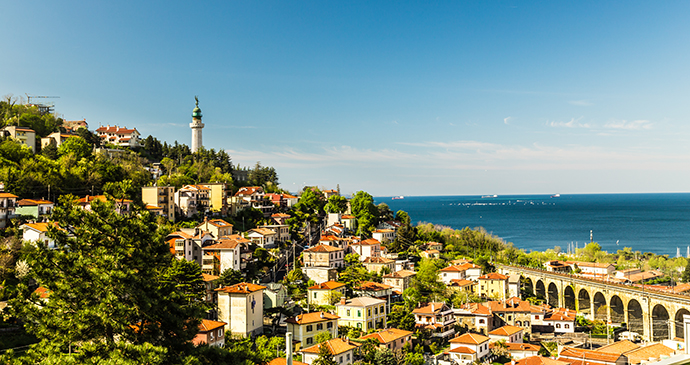 Trieste is an enthralling cosmopolitan city of a hundred faces © zakaz86, Shutterstock
Trieste is an enthralling cosmopolitan city of a hundred faces © zakaz86, Shutterstock
Trieste
There’s no city in Italy quite like it: the one place where you’re more likely to see sausages and sauerkraut on your plate than pasta and tomato sauce, where the most impressive church is Serbian Orthodox, where there are 67 different ways of ordering a cup of coffee. Trieste is multi-lingual, mitteleuropäisch, and mad about culture, a city with 32 museums and a great love for good music. It is the only city where we’ve ever been chased down the street by a klezmer band on stilts.
Once a true world city, the main seaport of the Austro-Hungarian Empire, two World Wars left Trieste a woebegone widow of the Adriatic, a grandiose Neoclassical city shorn of its raison d’être. Film titles like Sleeping Car to Trieste and Fugitive in Trieste (all filmed elsewhere) captured the post-war image of the place as a grim town on the hem of the Iron Curtain, fraught with spies and danger.
With the fall of that Curtain, all this has changed: Trieste is now a very merry widow, quickly regaining its old cosmopolitan lustre, its past something that the inhabitants accept as simply another twist in a very knotted history. The streets and shops bubble with a babel of Slovenian, Croatian, German, Hungarian and Czech, and cars bearing an exotic bouquet of number plates clog up the straight, Habsburgian, 18th-century streets. After decades of a depressed economy, trade is finally picking up too, with the help of some cutting-edge scientific research, with Slovenes and Hungarians flashing new-found wealth, and German and Czech businessmen seeking new Mediterranean markets.
Thanks to their geography and their difficult history, the Triestini often speak of their sense of being ‘at the end of the world’ (or at least, the end of Italy, which is the same thing). Jan Morris shares the same feeling in a brilliant book, her last: Trieste and the Meaning of Nowhere. After dwelling on Trieste’s odd destiny, its unique character and sense of place, she concludes: ‘To my mind this is an existential kind of place, and its purpose is to be itself.’
What struck Morris the most about the Triestini was their everyday kindnesses, their decency and cultured civility. Perhaps in the tough years Trieste was simply doing what good cities do in times of adversity: they ride it out and take the opportunity to perfect their discreet charms.
It’s a new world, and Trieste is at the end of it no longer – it’s all one free, amiable Europe now, in every direction. Instead of existential melancholy, you can sense the energy and excitement of a city shaking off decades of troubles and decline. The city still has some work to do, but it seems entirely possible that just by being itself, Trieste someday soon could be the Next Big Thing.
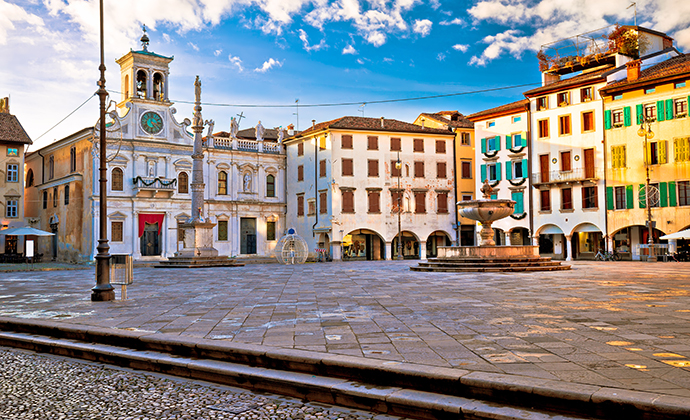 Piazza San Giacomo is a convivial place where the Udinesi come in the evening to meet up over an aperitivo © xbrchx, Shutterstock
Piazza San Giacomo is a convivial place where the Udinesi come in the evening to meet up over an aperitivo © xbrchx, Shutterstock
Udine
The bosses and the bureaucrats of Friuli Venezia Giulia may live in Trieste, but the sentimental capital of Friuli will always be here. Udine is a charmer, and not half as well known as it deserves to be. Its centre is a patch of calm and urbanity packed into a single square kilometre. If Udine were in Tuscany, everyone would know about it, and the streets and cafés would be as jammed full of tourists as Pisa or Siena. As it is, tucked away in the heart of Friuli, you can enjoy the sights and meet the Udinesi in an air of sweet serenity.
It is a city that, as one local writer notes with despair, che cambia poco – it changes little. That’s not all bad. Like many of the historic cities of Italy that history has left behind, it has polished its graces and learned to become a cosy, convivial world in itself. Its biggest attractions come from the period of Venetian rule. You shouldn’t miss Tiepolo’s frescoes in the Museo Diocesano, and the Piazza della Libertà, the heart of the city, may be the most Venetian thing anywhere outside Venice itself.
Related books
For more information, see our guide to Italy: Friuli Venezia Giulia:
Related articles
From ancient UNESCO sites to stunning mountain ranges and lagoon beaches, this little-visited region has it all.
FVG is jam-packed with beautiful art and architecture. Find out which sites have made it into our top five.
Friuli Venezia Giulia is a land of traditions, and its bell towers are amongst its most iconic.
Friuli Venezia Giulia is home to numerous UNESCO sites, but one of the best is the star city of Palmanova.
Discover the true past of Italy’s most famous dessert: the tiramisù.
Discover a new side to Italian cuisine with a foodie tour of Friuli Venezia Giulia.
